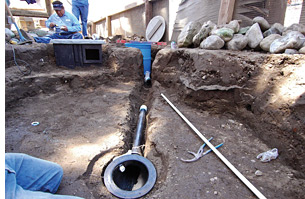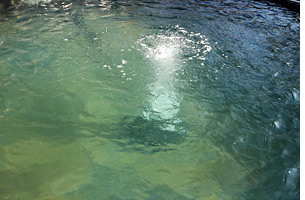|
 We only recommend Gravity Flow Bottom Drain Installations as opposed to direct suction drain installations. Gravity flow means we are plumbing the bottom
drain to a pre-filtration unit and from the pre-filtration unit we are draining water with a pond pump and sending the water to filtration. For example, the drain
can be plumbed to a settling chamber, a settlement tank, a skimmer, or sieve filter. Where ever you are draining your pond bottom drain to will be at the same water level as your pond
and by removing water from this pre-filter, the law of gravity is pulling water from the pond through the bottom drain line to fill the pre-filter back up.
We only recommend Gravity Flow Bottom Drain Installations as opposed to direct suction drain installations. Gravity flow means we are plumbing the bottom
drain to a pre-filtration unit and from the pre-filtration unit we are draining water with a pond pump and sending the water to filtration. For example, the drain
can be plumbed to a settling chamber, a settlement tank, a skimmer, or sieve filter. Where ever you are draining your pond bottom drain to will be at the same water level as your pond
and by removing water from this pre-filter, the law of gravity is pulling water from the pond through the bottom drain line to fill the pre-filter back up.
There are many different options where you can GRAVITY FLOW your bottom drain to. Some options are more difficult to install than others, some bottom drain installations are easier
to maintain than others and of course the cost of gravity flowing your pond drain to a determined pre-filter varies greatly! Which ever the case, I am not a fan of plumbing bottom drains directly to the pump and I will NOT assume the reasons are obvious. If you use direct suction pond drain
technology in a koi pond, here is what you set yourself up for. Fish poop, among other things, makes its way to the direct suction drain (typically 2" or 2 1/2" PVC line)
and is rapidly sent to a strainer basket in front of a pond pump.
Fish poop is blended up "Margarita style", without the ice, yummy flavor or intoxicating effect, and is sent to a pond filter in a very messy way.
For you pond keepers below the age of 21 we can refer to it as a Fish Poop Smoothie. The strainer basket in front of the pond pump likely needs to be opened and cleaned
once a week however I have seen extreme cases where the homeowner was cleaning their strainer basket several times a week! Because of a well designed Gravity Flow Pre-Filtration
System, I've only cleaned the strainer basket on my pond pump once in the last 11 months and it didn't even really need to be cleaned!
 Now that we all accept gravity flow technology as the superior construction method over direct suction technology, we
have speed limits we need to recognize. Most ponds will require 3" or 4" bottom drains so we will only cover these pipe sizes in this exercise.
Now that we all accept gravity flow technology as the superior construction method over direct suction technology, we
have speed limits we need to recognize. Most ponds will require 3" or 4" bottom drains so we will only cover these pipe sizes in this exercise.
3" Gravity Flow Bottom Drains should optimally have a max flow rate of approximately 1800 gallons per hour and will service an 8' diameter pond bottom nicely.
4" Gravity Flow Bottom Drains should optimally have a max flow rate of approximately 3600 gallons per hour and will service a 10' diameter pond bottom nicely.
Please do not ignore these speed limits like we know you do on the freeways! If you flow water faster than these speed limits the velocity of the water will begin to break up solids such as
fish poop defeating one of our main purposes and on the flip side, if you flow too little water, you aren't removing solids from the pond in the most effective manner possible.
The service diameter of the gravity flow bottom drain can be enhanced greatly with a bowled excavation with the pond drain installed at the lowest point of the pond, with current jets flowing water
to the pond drain. Even more so with the addition of air to the top of the pond drain's dome. Current jets can be designed in the pond to create a slow vortex, spinning
solids to the bottom and heavy aeration from the top of the bottom drain actually pulls neutrally buoyant solids (like fish poop) directly into the suction of the Gravity Flow Bottom Drain.
I would say with these additions to a pond drain installation, IF YOU WANTED TO PUSH THE LIMITS, you could extend the service diameter of a 3" bottom drain to 12' and a 4" bottom to 14'.
Use these Bottom Drain Fundamentals that we use to professionally design Koi ponds each day. Keep in mind the length and width of your pond will
determine the recommended size & quantity of bottom drains. The number of drains (combined with total pond gallons and number of skimmers) will help us determine what size
pond pump is necessary for the life support system of the pond. I was never a wiz in History back in school but we sure can learn a lot about pond construction by keeping a
watchful eye on techniques and philosophies used over the years. The Bottom Drain philosophies of today are certainly on the rise and I predict will soon become main stream
in the industry as a standard item in all new pond construction, water gardens, eco-system and dedicated Koi ponds alike.
If you are undecided on whether a bottom drain is right for your pond design, if you need more help wrapping your arms around the concept or
you simply want to discuss options for your pond, please feel free to contact our office toll free (800)-522-5043 or visit our
TalkPonds Message Board and post your questions.
|











